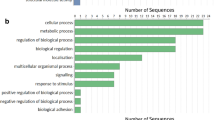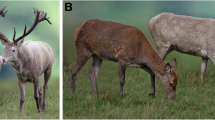Abstract
Background
The distinctive coat pattern of a Dalmatian is the result of the interaction of several loci. While the encoded function of these genes is not fully understood, it is known the Piebald, Ticking, and Flecking loci interact to produce the Dalmatian's classic pigmented spots on a white background. The color of the pigmented spots in purebred Dalmatians can either be black or liver, but the locus responsible for color determination is unknown. Studies have been conducted to determine the underlying genes involved in coat color determination in the dog, e.g., in the Labrador Retriever, but none to date have addressed black versus liver in the Dalmatian.
Results
A genome scan was conducted in a multi-generational kindred of Dalmatians segregating black and liver spot color. Linkage analysis was performed using a total of 113 polymorphic microsatellite markers from the kindred. Linkage was found between spot color and a single microsatellite marker, FH2319 (LOD = 12.5) on chromosome 11.
Conclusion
The TYRP1 (Brown) locus is located at position 50.1 Mb on chromosome 11, which is approximately 0.4 Mb from marker FH2319. Given the recent characterization of TYRP1 genetic variations in the dog and the linkage evidence reported here, TYRP1 is likely responsible for the spot color variation of black versus liver seen in the Dalmatian.
Similar content being viewed by others
Background
The distinctive coat pattern of a Dalmatian is the result of the interaction of several genes. Specifically, it is known the extreme piebald allele of the Piebald locus, in conjunction with the ticked allele of the Ticking locus, and nonflecked allele of the Flecking locus, produces pigmented spots on a white background [1]. The color of the pigmented spots in registered Dalmatians is black or liver [2], but the locus responsible for the color variation has not been identified in the Dalmatian. Other colors are rare, but can be found [3].
Several classic pigmentation loci, such as Agouti, Extension, and Brown, have been characterized at the molecular level. The Brown locus describes tyrosinase related protein 1 (Tyrp1), which controls the production of eumelanin in melanocytes [4]. In the dog, the dominant wild-type allele results in black eumelanin while the recessive brown allele results in brown eumelanin [1]. The Extension locus has been found to be the melanocortin 1 receptor (Mc1r) protein [5], which has an epistatic relationship with the Agouti locus [1]. The epistatic relationship between Agouti and Extension acts as a switch for melanocytes to produce either phaeomelanin or eumelanin, with certain alleles resulting in a red or reddish-brown color [6].
All Dalmatians are homozygous for the Piebald, Ticking, and Flecking loci (or they would not display the classic spotting pattern) complicating characterization of these loci through standard techniques, such as linkage analysis, since there is not a segregating phenotype to detect. However, black and liver spot color is a detectable phenotype that segregates in Mendelian fashion. The objective of this study was to utilize a previously described multi-generational kindred of Dalmatians [7] to conduct a genome scan and perform linkage analysis to detect linkage between spot color and a microsatellite marker. Detection of linkage will provide insight as to which locus may be responsible for black versus liver in the Dalmatian.
Results
Twopoint linkage analysis for spot color was performed using SOLAR v2.1.4 [14] and 113 polymorphic markers from the Dalmatian kindred. Marker FH2319 resulted in a statistically significant LOD score of 12.5 [8, 9]. FH2319 was previously mapped to chromosome 11 at position 49.7 Mb [10]. None of the remaining 112 markers resulted in a LOD score above the standard significance threshold of 3, including four additional polymorphic markers on CFA11. The spot color and corresponding genotypes for a subset of the kindred are shown in Figure 1.
Discussion
A genome scan was performed on a multi-generational kindred of Dalmatians, previously analyzed for heritability and segregation of deafness [7]. Spot color has been shown to not be associated with deafness in the Dalmatian [7]. Twopoint linkage analysis using SOLAR produced a LOD score of 12.5 for marker FH2319 on chromosome 11. Based on the canine genome map [10], the TYRP1 (Brown) locus is at position 50.1 Mb, which is approximately 0.4 Mb from FH2319. Given the recent characterization of TYRP1 genetic variations in the dog [11] and the linkage evidence reported here, TYRP1 is likely responsible for the spot color variation of black versus liver seen in the Dalmatian.
Included in Figure 1 are suspected alleles of the Brown locus for the depicted dogs. Dog 3 is heterozygous for the dominant B allele of the Brown locus (producing black spots) while dog 4 is homozygous for the recessive b allele of the Brown locus (producing liver spots). Progeny of dogs 3 and 4 reveal marker FH2319 allele 289, in this family, is linked with the B allele of the Brown locus. Additional alleles of marker FH2319 were also linked with the B allele in the Dalmatian kindred (data not shown). Due to this fact, linkage alone is not enough to establish if a dog with an unknown Brown locus genotype (such as dog 2 in Figure 1) is homozygous or heterozygous for the dominant allele.
A recent study [11] examined genetic variations in the TYRP1 and MC1R loci in numerous dog breeds to determine the effect of the variations on black and brown pigmentation. While this work characterized the associations of specific mutations found in these genes with the pigmentation phenotypes examined, only one Dalmatian (with black spots) was included. Based on examination of the kindred reported here, the TYRP1 gene should be further characterized in the Dalmatian to determine the specific genetic variations associated with the dominant and recessive alleles of the Brown locus.
Conclusion
Statistically significant linkage was found between marker FH2319 and spot color in a kindred of Dalmatians. FH2319 is 0.4 Mb from the TYRP1 locus, supporting evidence that its gene product is responsible for the black or liver color of a Dalmatian's spots. Further characterization of TYRP1 in the Dalmatian is warranted to determine the specific genetic variations causative for color variation.
Methods
Spot color
Spot color was recorded from the Dalmatian kindred as previously described [7]. There were a total of 139 dogs with black spots (61 males, 78 females) and 60 with liver spots (26 males, 34 females). For the purpose of linkage analysis, spot color was coded as a binary trait with '0' for black and '1' for liver.
DNA samples
Genomic DNA was isolated from 117 dogs (54 males, 63 females) of the Dalmatian kindred reported [7]. The remaining 149 dogs of the kindred were unavailable for collection of a DNA sample. The PUREGENE DNA Isolation Kit (Gentra Systems, Minneapolis, MN, USA) was used to extract genomic DNA from either whole blood or buccal swabs according to the manufacturer's specifications.
Microsatellite markers
Microsatellite markers were amplified and resolved in multiplexed sets as described [12]. A linkage map of the markers based on the Dalmatian kindred was previously described [13]. Out of 172 total markers analyzed, 113 were polymorphic in the assembled Dalmatian kindred.
Linkage analysis
Twopoint linkage analysis was performed using the program SOLAR v2.1.4 [14] according to the developers' instructions.
References
Sponenberg DP, Rothschild MF: Genetics of coat colour and hair texture. The genetics of the dog. Edited by: Ruvinsky A, Sampson J. CABI Publishing, New York, NY; 2001:61-85.
The Dalmatian Club of America. [http://www.thedca.org]
Brooksbank S, MacMillan S, Wymore S: The Dalmatian standard. The official book of the Dalmatian. Edited by: Brooksbank S, MacMillan S, Wymore S. TFH Publications, Neptune, NJ; 1997:123-172.
Jackson IJ: Molecular and developmental genetics of mouse coat colour. Ann Rev Gen. 1994, 28: 189-217. 10.1146/annurev.ge.28.120194.001201.
Newton JM, Wilkie AL, Lin H, Jordan SA, Metallinos DL, Holmes NG, Jackson IJ, Barsh GS: Melanocortin 1 receptor variation in the domestic dog. Mam Gen. 2000, 11: 24-30. 10.1007/s003350010005.
Berryere TG, Kerns JA, Barsh GS, Schmutz SM: Association of an Agouti allele with fawn or sable coat color in domestic dogs. Mam Gen. 2005, 16: 262-272. 10.1007/s00335-004-2445-6.
Cargill EJ, Famula TR, Strain GM, Murphy KE: Heritability and segregation analysis of deafness in U.S. Dalmatians. Genetics. 2004, 166: 1385-1393. 10.1534/genetics.166.3.1385.
Lander E, Kruglyak L: Genetic dissection of complex traits: Guidelines for interpreting and reporting linkage results. Nat Gen. 1995, 11: 241-247. 10.1038/ng1195-241.
Gordon D, Corwin MB, Mellersh CS, Ostrander EA, Ott J: Establishing appropriate genome-wide significance levels for canine linkage analyses. J Hered. 2003, 94: 1-7. 10.1093/jhered/esg009.
Guyon R, Lorentzen TD, Hitte C, Kim L, Cadieu E, Parker HG, Quignon P, Lowe JK, Renier C, Gelfenbeyn B, Vignaux F, DeFrance HB, Gloux S, Mahairas GG, Andre C, Galibert F, Ostrander EA: A 1-Mb resolution radiation hybrid map of the canine genome. Proc Nat Acad Sci. 2003, 100: 5296-5301. 10.1073/pnas.0831002100.
Schmutz SM, Berryere TG, Goldfinch AD: TYRP1 and MC1R genotypes and their effects on coat color in dogs. Mam Gen. 2002, 13: 380-387. 10.1007/s00335-001-2147-2.
Cargill EJ, Clark LA, Steiner JM, Murphy KE: Multiplexing of canine microsatellite markers for whole-genome screens. Genomics. 2002, 80: 250-253. 10.1006/geno.2002.6827.
Cargill EJ, Schnabel RD, Murphy KE: Assignment of canine MSS1 microsatellite markers to chromosomes by linkage data. DNA Seq. 2004, 15: 209-212.
Almasy L, Blangero J: Multipoint quantitative-trait linkage analysis in general pedigrees. Am J Hum Gen. 1998, 62: 1198-1211. 10.1086/301844.
Acknowledgements
The authors would like to acknowledge the commitment of the Dalmatian Club of America, breeders and their veterinarians who contributed samples to the project. This work was supported by the American Kennel Club Canine Health Foundation grants Number 1870 and Number 2264. E.J.C. was supported by a National Institutes of Health (National Institute on Deafness and other Communication Disorders) Individual National Research Service Award predoctoral fellowship (1F31DC05297).
Author information
Authors and Affiliations
Corresponding author
Additional information
Authors' contributions
EJC participated in design of the study, collected samples, performed the genome scan and linkage analysis, and drafted the manuscript. TRF was involved with the linkage analysis and review of the manuscript. RDS was involved with the linkage analysis and review of the manuscript. GMS was involved with collection of samples and review of the manuscript. KEM conceived of the study, participated in its design and coordination, and review of the manuscript.
Authors’ original submitted files for images
Below are the links to the authors’ original submitted files for images.
Rights and permissions
Open Access This article is published under license to BioMed Central Ltd. This is an Open Access article is distributed under the terms of the Creative Commons Attribution License ( https://creativecommons.org/licenses/by/2.0 ), which permits unrestricted use, distribution, and reproduction in any medium, provided the original work is properly cited.
About this article
Cite this article
Cargill, E.J., Famula, T.R., Schnabel, R.D. et al. The color of a Dalmatian's spots: Linkage evidence to support the TYRP1gene. BMC Vet Res 1, 1 (2005). https://doi.org/10.1186/1746-6148-1-1
Received:
Accepted:
Published:
DOI: https://doi.org/10.1186/1746-6148-1-1





